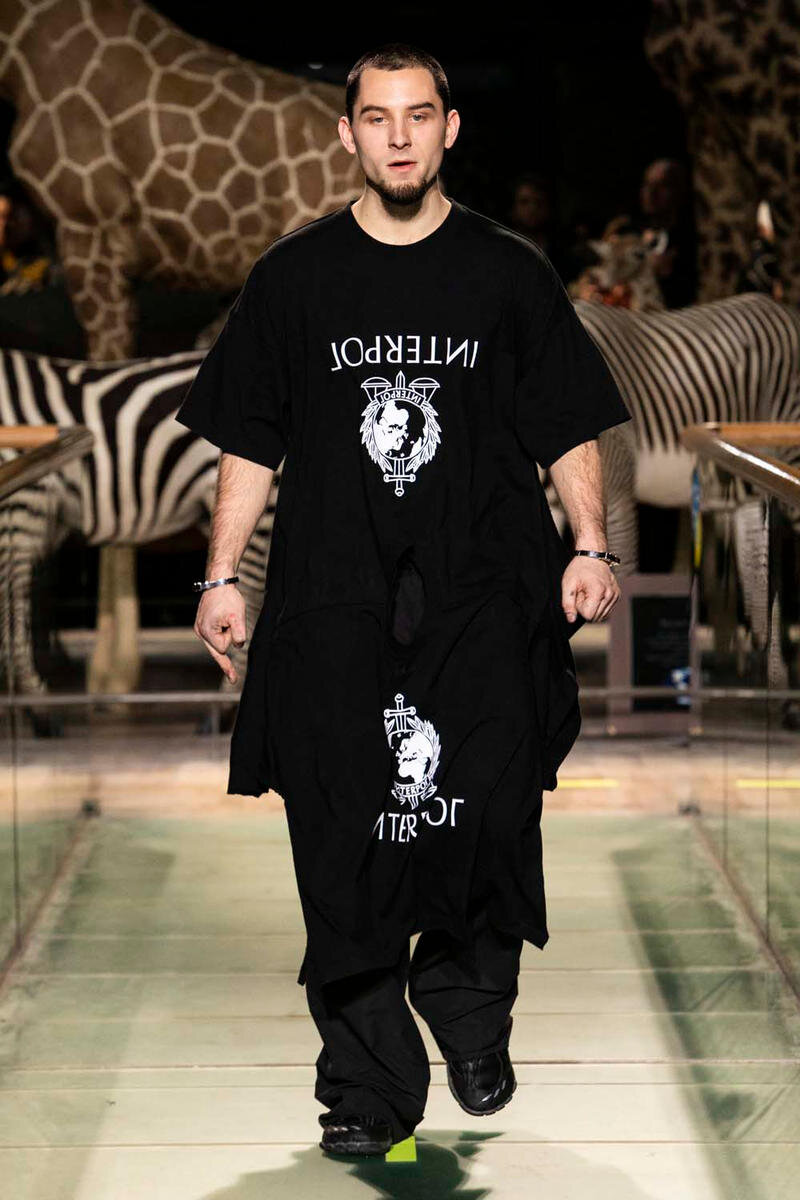The Irony of Ironic Fashion

As consumers, we are so caught up in the speed with which new designs come our way that we often fixate on originality more than taste. Brands push to catch the eye of a generation accustomed to scrolling quickly and mindlessly. They rely on nostalgia and humor when simple intrigue no longer feels like enough. This has spawned a movement within the fashion industry that capitalizes on irony. Ironic clothes are traditionally and universally recognized as ugly, ridiculous, cheesy or cheap. The appeal is therefore not only in the way the clothes reference the darker fashion days of our childhoods and the whimsy that was present then. It is the fact that your grandmother will never understand, but you and your fashion-forward friend will.
Fashion houses like Balenciaga, Gucci, Moschino and Vetements are among the many embracing irony in the pieces they send down the runway. Gucci’s “web” or “grip strap” sandals are just two of the styles reminiscent of required attire for a whitewater rafting trip, and their jelly sandals are just a slightly upscale version of the shoes my parents put me in when I could not be trusted with destructible fabric. Balenciaga has turned crocs and dad-sneakers — seemingly antithetical to anything fashionable — into almost $900 shoes. Moschino created a garment bag-inspired dress while Vetements has turned slouchy t-shirts and sweatshirts into high fashion. For all brands involved in this movement, the expensive price tag and revered logos that adorn the garments, turn the clothes from cheap to chic. While theoretically promoting inclusivity and creativity in the fashion realm, this trend loses its potential for good in its promotion of cynicism, as well as intellectual and economic elitism.
The advent of ironic fashion was not as recent as its supposed originality might imply. The ‘90s saw the rise of ironic fashion similar to what we see today. As target consumers of high fashion were then not only educated, but also newly immersed in television and advertising, ironically embracing the banality of mainstream trends seemed genuine and refreshing. The notion of the hipster was still novel.
Even before that, the concept was not foreign in art in general. “Kitsch” used to describe cheapness, or art that draws from pop culture and therefore is easily accessible and generally unexciting. Kitsch took on a new meaning, however, in the mid to late 20th century. Skewed to mimic but still mock pop culture influence in art, the notion of “camp” grew from the appeal of exclusivity. It takes knowing that it would be ridiculous to take the conventionality of the work seriously to appreciate the humor in it. Thus jeans became a staple of everyone’s wardrobe. Guided by heavy advertising, a once practical piece of work attire became a comedic distortion of what it was. Jeans still held a relatable, one-with-the-working-class connotation, but high prices also said that the person wearing them “knew better.” Jeans were one of the earliest and largest reversals of the intended meaning behind a piece of clothing: their prevalence tells us that embracing anti-fashion as couture is natural.




I must admit that this movement makes sense — there is something to appreciate in anti-fashion fashion. Comfort, for one, is a valid reason to support the emergence of “ugly” fashion. As chunky sneakers and oversized sweatshirts replace stiff heels and fitted dresses, it is no surprise that women in particular are drawn to the change. There is also a sense of freedom that comes with abandoning mainstream styles: people can make expression a personal endeavor rather than one dictated by external standards. In theory, anti-fashion fashion is freeing in that it is relatable. It reminds us of the items we have hidden away in our closet or the ones we wear when one no one is looking. Older generations may make fun of those paying for Balenciaga crocs like they do those buying pre-distressed jeans, but the consumers are operating with the same intent: there is a casual and accessible appeal. It feels unedited, especially for people who feel excluded from the more classic take on the fashion world.
And while many of us welcome this opportunity to excuse a wardrobe disaster as deliberate, we find ourselves asserting that it is “ironic.” This need to be ostensibly “in the know” is telling of the problem with ironic fashion — it is not as inclusive as it appears.
The fact that this movement is not new is part of that problem. It is cynicism for the sake of cynicism rather than cynicism with any sense of originality. We have all seen and tried the hipster act and it has lost its novelty. We have come to the same realization: thinking you are better than everything is only entertaining for so long and it is no more tasteful than the lack of taste it mocks. Ironic fashion capitalizes on the whimsy that kitsch provides but demeans it, which besides feeling immoral, feels nonconstructive. It does not offer an exciting alternative to the “boring” mainstream nor a serious one to the ridiculous camp. The result is a movement that feels posed. It tries desperately to say something different, and consequently says nothing.
Yet, the potential benefits of an anti-fashion fashion movement, such as comfort and creativity, are ignored. First, the movement is only accessible to the generation that is both young and old enough for the pieces to be ironic, so any sense of creativity does not extend far. In addition, the qualities of these pieces that the mainstream loves become irrelevant, as they oppose the elitist outlook established. The excitement of ironic fashion is not the surprise itself, but the haughtiness of understanding the surprise when others do not. It prides itself on inherently elitist intellectualism, as understanding the irony in a piece implies a level of understanding of fashion (or art) history.
Finally and most obviously, the exclusivity of “ugly” fashion is also financial. To be done right, the irony has to be so obvious that it cannot be mistaken for being simply ugly clothing. For those who cannot rely on their ethos to tell others that they are, in fact, clued in, so much of kitschy clothing centers around logos and other forms of brand recognition. It is never just wearing the sandal, but wearing the $900 version. The movement becomes inaccessible to all those unwilling to spend hundreds on the best plain hoodie or platform sneakers. The pieces become acceptable not because they say something clever or funny, but simply because they are expensive. One need not even be clued into the intellectual side of camp to participate which undoes its (already flawed) purpose.
Vetements founder Demna Gvasalia said in his interview with SSENSE, “we do not want to be part of an idea of fashion that is about glamour and about something unattainable or super exclusive.” While his work was certainly not about glamour, it was perhaps less attainable and inclusive than “glamorous” fashion, which was not built on exclusivity. I do not mean to say that we need to leave behind our ugliest outfits and focus only on serious, conventionally beautiful clothing. I just mean that the movement as is feels arbitrary and limited. It does not need to center around knowing more, having more and poking fun, but around experimenting with choices, taking risks and taking things more lightly. In essence, the movement needs the sense of humor that it disingenuously nods to.
















